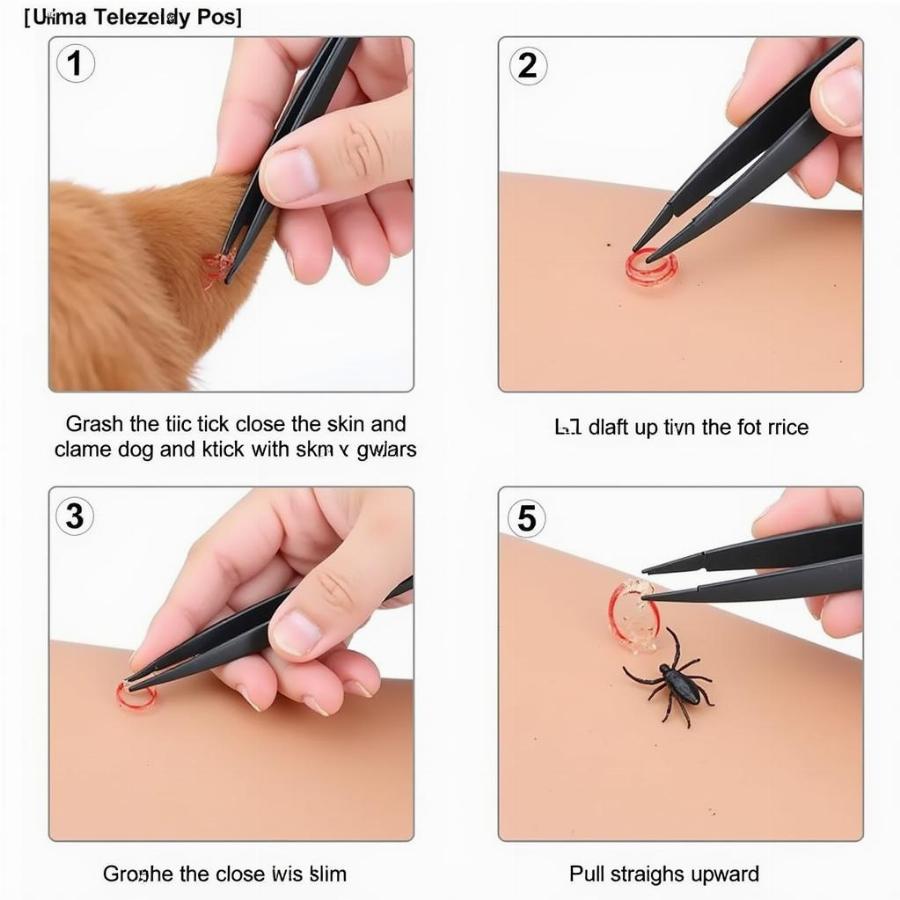Ticks on dogs are a common concern for pet owners, especially during warmer months. Finding these small, parasitic arachnids latched onto your furry friend can be alarming. Knowing how to identify ticks on dogs through pictures, safely remove them, and prevent future infestations is crucial for maintaining your dog’s health and well-being. This article provides a comprehensive guide to understanding ticks on dogs, using images to aid in identification, and outlining effective prevention and removal strategies.
What Do Ticks on Dogs Look Like?
Recognizing a tick is the first step in protecting your dog. Ticks vary in size depending on their species and life stage. They can range from tiny specks, resembling poppy seeds, to larger, engorged creatures the size of a grape. Their color can also vary, from reddish-brown to dark brown or even black. Pictures of ticks on dogs can be extremely helpful in visualizing these variations.
Identifying Different Tick Species
There are several tick species that can infest dogs. Some of the most common include the American dog tick, the deer tick (also known as the blacklegged tick), and the brown dog tick. While they share similarities, there are subtle differences in appearance. Examining dog ticks pictures is a valuable tool for learning to differentiate between species.
How to Remove a Tick from Your Dog
If you find a tick on your dog, prompt removal is essential. Using fine-tipped tweezers, grasp the tick as close to the skin as possible. Pull upward with steady, even pressure. Avoid twisting or jerking, as this can break off the tick’s mouthparts, leaving them embedded in the skin.  Proper Tick Removal Technique on a Dog After removal, clean the area with antiseptic and dispose of the tick by sealing it in a bag or flushing it down the toilet.
Proper Tick Removal Technique on a Dog After removal, clean the area with antiseptic and dispose of the tick by sealing it in a bag or flushing it down the toilet.
What Not to Do When Removing a Tick
There are several common misconceptions about tick removal. Never try to burn a tick off or smother it with petroleum jelly. These methods can cause the tick to regurgitate, increasing the risk of transmitting disease. After learning the proper method using dog ticks pictures, stick to the recommended technique.
Preventing Ticks on Dogs
Preventing tick infestations is the best way to protect your dog from tick-borne diseases. Regularly apply a veterinarian-recommended tick preventative, such as topical treatments, oral medications, or tick collars. Keep your lawn mowed short and remove leaf litter to reduce tick habitats. After walks in wooded or grassy areas, carefully check your dog for ticks, paying close attention to areas like the ears, neck, and paws. Similar to dealing with parasites on dogs, prevention is key.
Year-Round Tick Protection
While ticks are most active during warmer months, they can be present year-round in some climates. Maintaining year-round tick prevention, as advised by your veterinarian, is vital, especially if you live in an area with a high tick population. Just like understanding how do you get rid of parasites in dogs, knowing how to check for ticks is essential.
Conclusion
Protecting your dog from ticks requires vigilance and proactive measures. Learning to identify ticks through ticks on dogs pictures, understanding effective removal techniques, and implementing preventative strategies are crucial for safeguarding your dog’s health. Regularly check your dog for ticks, especially after outdoor activities, and consult with your veterinarian about the best prevention methods for your dog’s lifestyle and environment. By staying informed and taking appropriate action, you can keep your canine companion safe from these tiny but significant threats.
FAQ
- What diseases can ticks transmit to dogs? Ticks can transmit diseases such as Lyme disease, ehrlichiosis, and anaplasmosis.
- How often should I check my dog for ticks? Check your dog daily, especially during tick season, and after spending time outdoors.
- What should I do if I find an embedded tick? Consult your veterinarian for safe removal.
- Are there natural tick repellents for dogs? Discuss natural options with your vet before use.
- How long can a tick survive on a dog? Ticks can feed on a dog for several days to weeks.
- Can ticks infest my home? Yes, certain tick species can infest homes, especially if brought in by pets.
- How effective are tick collars? Tick collars can be effective, but consult your veterinarian for the best option for your dog.
Further Reading
You might be interested in reading more about dogs with brown and white spots or exploring other related topics on our site, such as dog ticks pictures.
Beaut Dogs is your trusted source for all things related to dog care. We provide expert advice and valuable information to help you provide the best possible care for your beloved canine companion. For personalized guidance, please contact us at [email protected]. Beaut Dogs is here to support you and your furry friend every step of the way.